Editor’s note
High-resolution climate projection data using regional downscaling techniques are key to successful assessments of local climate features in order to facilitate mitigation and adaptation to climate change, reduction of climate-related disaster risks and the realization of sustainable development. Starting from 2013, APN has been supporting a regional initiative, now known as SEACLID/CORDEX-SEA, to conduct high-resolution coordinated climate downscaling activities within countries in Southeast Asia. The APN Secretariat conducted an interview with the project leader, Professor Ferdolin Tangang of the National University of Malaysia, to find out more about this project and its potential impacts.
Index
Q2: Why did SEACLID and CORDEX decide to coordinate? What was the driving process behind this?
APN Secretariat: Very briefly, in layman terms, what is SEACLID/CORDEX-SEA, and what drives the establishment of this initiative?
Professor Fredolin Tangang (FT): SEACLID is an acronym for Southeast Asia Regional Climate Downscaling while CORDEX is an abbreviation for COordinated Regional Climate Downscaling Experiment. SEACLID is a bottom-up initiative by scientists from countries within Southeast Asia, which was established in November 2013 and funded by the Asia-Pacific Network for Global Research (APN) and institutions within the countries involved in the project. The project was born out of a workshop in Hanoi, Viet Nam in early August 2012, which was convened by me and hosted by Professor Phan Van Tan of VNU Hanoi University of Science. In this workshop, an agreement was reached for a project proposal for a regional climate downscaling project to be developed and subsequently submitted to APN for funding consideration. Initially, there were seven countries who participated in this project including Malaysia, Thailand, Indonesia, Viet Nam, Philippines, Lao PDR and Cambodia.
SEACLID aims to downscale (or “refine”) coarser outputs of general circulation models (GCMs) (with 100-300 km horizontal resolution) to high-resolution climate projection data (25 km x 25 km) using regional climate models (RCMs) for meeting the data needs of countries in the region. By refining the GCM data into data with much higher resolution, local features and processes may be resolved better by RCMs and hence downscaled products may provide added value. Despite the bottom-up nature of this initiative, it is actually driven by the need to address issues pertaining to mitigation and adaptation to climate change, sustainable development and climate-related disaster risk reduction, which are the essence of the top-down agendas of international agreements or accords such as the Sustainable Development Goals (SDGs), the Paris Agreement and the Sendai Framework for Disaster Risk Reduction. After its inception, SEACLID was then streamlined into CORDEX, an initiative under the World Climate Research Programme (WCRP), and became its fourteenth domain. The project was then renamed as SEACLID/CORDEX Southeast Asia. Subsequently, after its incorporation into CORDEX, a number of countries outside the region joined the initiative including UK, Republic of Korea, Australia, Germany, Japan, Hong Kong SAR and Sweden. Readers are invited to visit the project website for more information at http://www.ukm.edu.my/seaclid-cordex and the CORDEX website at http://www.cordex.org.

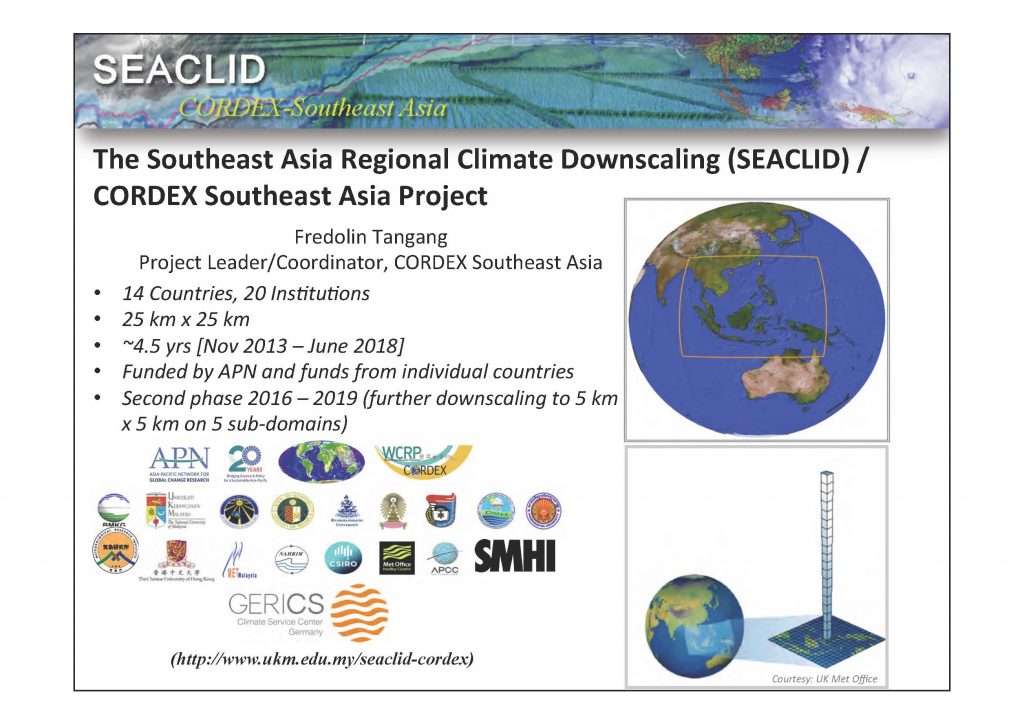
APN Secretariat: Why did SEACLID and CORDEX decide to coordinate? What was the driving process behind this?
FT: Both SEACLID and CORDEX are platforms for scientists to work collaboratively and carry out the regional climate downscaling exercises in a coordinated fashion. For Southeast Asia, SEACLID is the most logical option for countries to follow given the fact that for robust regional climate change projection information, multiple GCMs, multiple RCMs and emission scenarios are required, making this kind of model data “refining” a very resource-expensive (computer and cost) and time-consuming exercise. Through SEACLID, this exercise was coordinated, where the tasks were distributed among members. However, SEACLID was not only about downscaling the GCM outputs but also providing scientists within and outside the regions with the opportunity to enhance their collaborative network, increase technical capacity in regional climate modelling and capacity building with the participation of MSc and PhD students in the project. Eventually, this project would increase the visibility of scientists from this region in scientific publications. CORDEX, which promotes the same idea but with worldwide coverage, is even more relevant where is it a top-down programme under the World Climate Research Programme (WCRP). Hence there was a requirement for SEACLID to be streamlined into CORDEX. This was also the intention of SEACLID members right from the initial stage of this project. It was also APN’s recommendation that SEACLID be integrated into CORDEX. The integration was greatly facilitated and very much welcomed by Dr Ghassem Asrar, the WCRP Director at that time. SEACLID was then transformed into the fourteenth domain of CORDEX and renamed as SEACLID/CORDEX Southeast Asia. In Asia, there are three CORDEX domains, namely CORDEX South Asia, CORDEX East Asia and CORDEX Southeast Asia.
APN Secretariat: Why is the project important to Southeast Asia, and how will the outcomes contribute to the next IPCC Assessment?
FT: Southeast Asia is lagging behind in many aspects related to knowledge advancement pertaining to the understanding of the science of regional climate change and its impacts. Yet, it is recognized that the region is highly exposed and highly vulnerable to the impacts of climate change. The Southeast Asia region, with a population of more than 0.5 billion, comprises mainly developing and least developed countries that have least or no technical capabilities to generate robust local and regional climate change information to address issues related to climate change. According to the Fifth Assessment Report of IPCC WGII (AR5, Chapter 24), there was a critical lack of information on how climate change is going to impact critical sectors in Southeast Asia. This lack of information would certainly render inaction or, worse, would drive a wrong decision by policymakers in the region which could increase the likelihood of maladaptation in their quest to address issues related to climate change.
While SEACLID/CORDEX Southeast Asia has now generated the multi-GCM, multi-RCM and multi-emission scenario climate projection data, these data would need to be translated by the VIA community of scientists in this region into robust information on how future climate changes that impact critical sectors in the region and narrow down the existing knowledge gaps. Hence, it is critical for funding agencies such as APN to recognize the importance of such impact assessment projects using SEACLID/CORDEX Southeast Asia products to be funded and carried out.
The scientific publications of these VIA studies together with those of SEACLID/CORDEX Southeast Asia would eventually narrow down knowledge gaps and provide more published literature for the IPCC AR6 assessment process. In addition, SEACLID/CORDEX Southeast Asia outputs, together with additional runs that are being planned, will contribute to CORDEX-CORE. CORDEX-CORE is a new coordinated regional climate downscaling by CORDEX that aims to ensure homogeneity across domains for the purpose of the production of a regional atlas, which may be required for regional chapters of the IPCC AR6. At this stage, discussions on how CORDEX-CORE and can meet IPCC AR6 requirements are currently underway.
APN Secretariat: From the perspectives of Sustainable Development Goals, how would high-resolution climate change scenarios help contribute scientific knowledge to decision making for development? Could you provide an example or two?
FT: The region of Southeast Asia is complex, existing of regional seas, complex land-mass distribution, numerous islands, large ocean such as the Indian and Pacific Oceans, and obvious influences of the monsoon. While GCMs would be able to resolve large-scale features, RCMs are capable of adding and incorporating these complexities. RCMs has been shown to provide added value to GCM outputs. With the high-resolution nature of RCM products, impacts of climate change at local and regional levels can now be addressed. The high-resolution data can input into impact assessment tools, e.g. hydrology or crop models. The data would, therefore, help provide much more robust information for impact assessments, leading to the development of climate adaptation strategies, which are local in nature. For example, in order to assess the impact of future climate change on existing infrastructure, e.g. drainage, human settlements or current agriculture practices, future climate change information at the local scale is required. With a proper adaptation strategy out of identified potential impacts from such an assessment, future impacts may be reduced or avoided. This chain of action, of course, subscribes to what is required in achieving the SDGs and is related to SDG goal 13 on climate action. In addition, addressing this goal through the means identified would directly and indirectly take into account other goals as well, such as SDG goal 1 on no poverty. Impacts of extreme climate events, e.g. flood and drought, exacerbate poverty. Reducing or eliminating future impacts of extreme events through adaptation would steer communities away from poverty cycles. In addition, with increased understanding of the science of regional climate change and its impacts, the level of awareness of many players, e.g. governments, NGOs, and society would increase and, hence, would place countries and nations in this region in a better position to address climate change and negotiate more effectively in international treaties such as the Paris Agreement, SDGs and the Sendai Framework for Disaster Risk Reduction (SFDRR).
APN Secretariat: You pointed out the lack of climate change impact assessment studies in Southeast Asia in your recent talk at the International Workshop on Climate Downscaling Studies, recently held in Tsukuba, Japan. How, in your opinion, can the research and donor communities’ best address this issue?
FT: This question has been partly addressed in Q3. Yes, according to the IPCC WGII Asia Chapter 24, critical gaps have been identified in terms of information availability of how future climate change would affect many critical sectors in the region. Although such lack of information can be due to many reasons, the unavailability of high-resolution and robust future climate projection data for the region could have largely contributed to this predicament. In the developed region, vulnerability, impact and adaptation (VIA) researchers have free access to such data products from the Earth System Grid Federation (ESGF), a platform where climate projection data from both GCMs and RCMs are archived for efficient dissemination. This has yet to be the case in the Southeast Asia region. However, the progress that has been made under SEACLID/CORDEX Southeast Asia is changing this situation. SEACLID/CORDEX Southeast Asia has established an ESGF Data Node and this is currently being hosted by the Ramkamhaeng University Center of Regional Climate Change and Renewable Energy (RU-CORE), Bangkok, Thailand. With funding from Ramkhamhaeng University, Thailand Research Fund (TRF) and National Research Council of Thailand (NRCT), the RU-CORE team members, with the technical expertise from the Swedish Meteorological and Hydrological Institute (SMHI) Sweden and the Indian Institute of Tropical Meteorology (IITM) India, have managed to establish this ESGF node, which is called the SEACLID/CORDEX Southeast Asia EGSF Data Node, at RU-CORE (http://www.rucore.ru.ac.th/). The SEACLID/CORDEX Southeast Asia team is currently in the process of uploading data onto the ESGF node. While the actual RCM data are stored at this node, the indexing is maintained by the SMHI ESGF Index node.
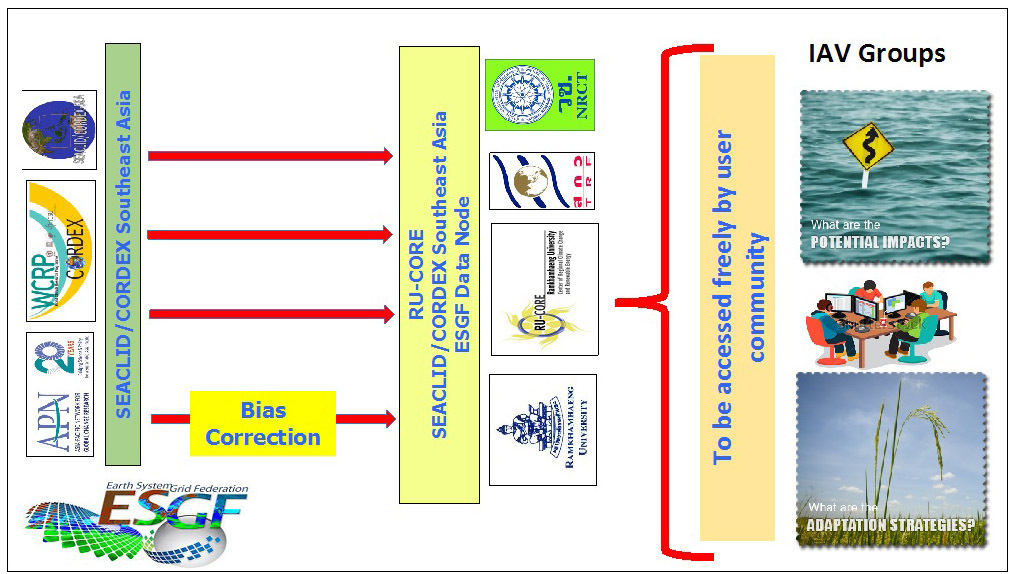
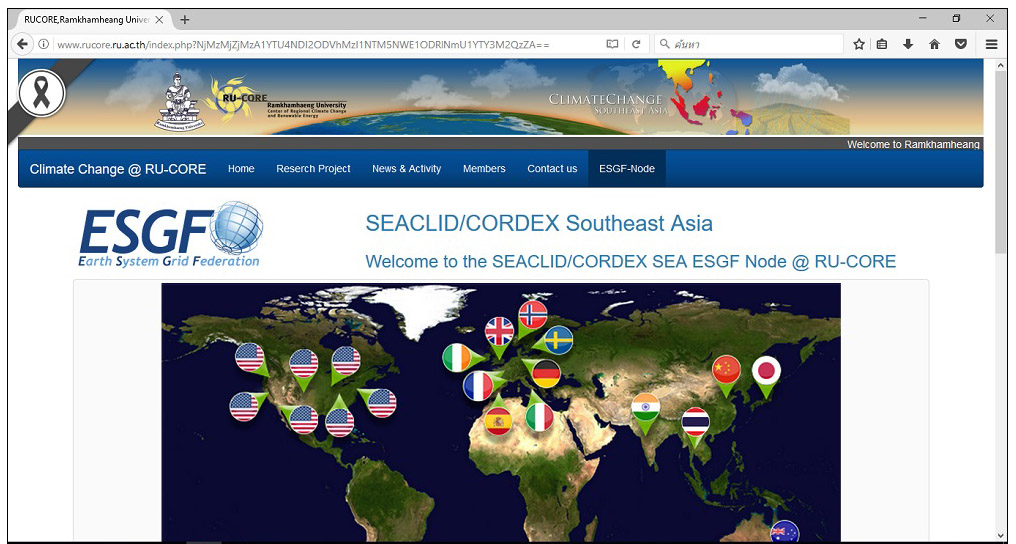
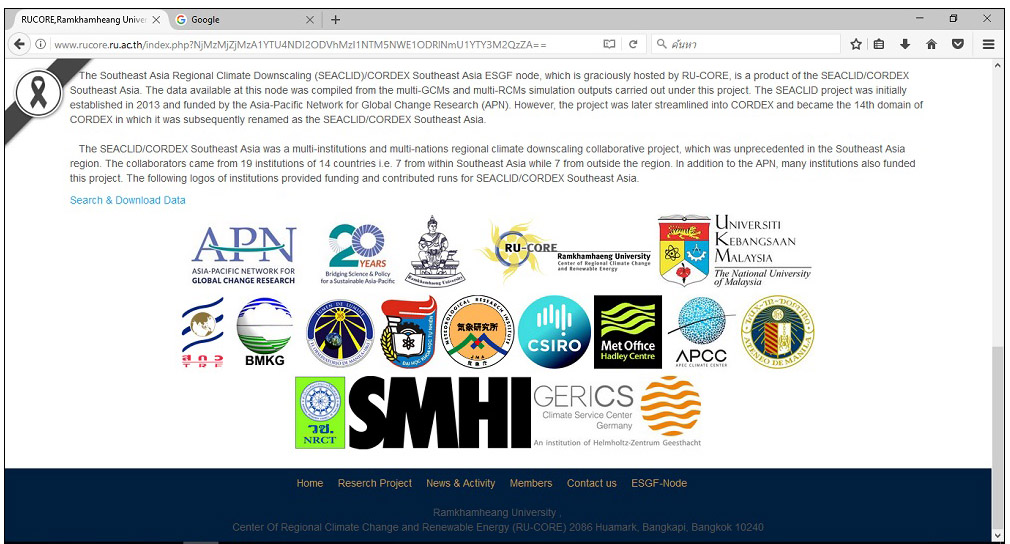

Creating modelled data using GCMs and then downscaling them with RCMs, translating (or “distilling”) them into information and subsequently archiving them is a long and tedious process. This process has been achieved within SEACLID/CORDEX Southeast Asia. However, for such information to be subsequently and successfully used by the VIA community in the region, a “bridging” program is considered necessary. Such a program is needed to facilitate the use of SEACLID/CORDEX Southeast Asia data by the VIA user community. A bridging program would facilitate and accelerate the establishment of climate change impact assessment projects in the region, which are needed to transform the downscaled data into information that can be used for related impact and assessment studies. Eventually, climate change impact assessment projects need to be developed using these data. Hence, this process entails the important roles of VIA researchers and the donor community.
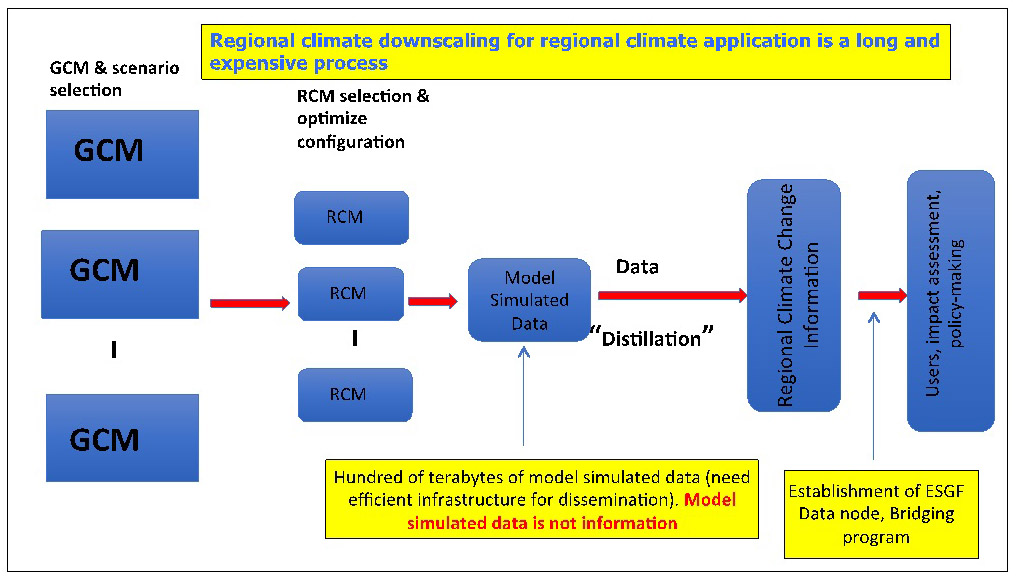
APN Secretariat: What are the main challenges in the work of SEACLID/CORDEX-SEA, and how do you envisage the project in the mid- and long-term future? For example, are there a sufficient number of early-career scientists to continue the work? Is more capacity building and awareness-raising needed?
FT: SEACLID/CORDEX Southeast Asia involves many groups and institutions within and outside the region. It was a real challenge to coordinate and ensure that the allocated tasks to a particular group were properly carried out. In many aspects, SEACLID/CORDEX Southeast Asia is a success story where, prior to this initiative, there had been no coordinated project in regional climate simulation. In contrast to CORDEX Africa, where regional climate simulations were carried out by centres outside Africa and the focus for scientists in Africa was only to use the generated data, in SEACLID/CORDEX Southeast Asia, modelling groups from five countries: Malaysia, Thailand, Indonesia, Viet Nam and the Philippines, conducted the downscaling simulations themselves. Given the limited resources we have in each modelling group, such a large exercise proved to be a daunting and difficult task. Additional simulations were also contributed by other groups from outside the region (see table below). However, coordination was not only in terms of conducting the simulations but also in terms of data movement, analysis of model outputs and writing scientific manuscripts.
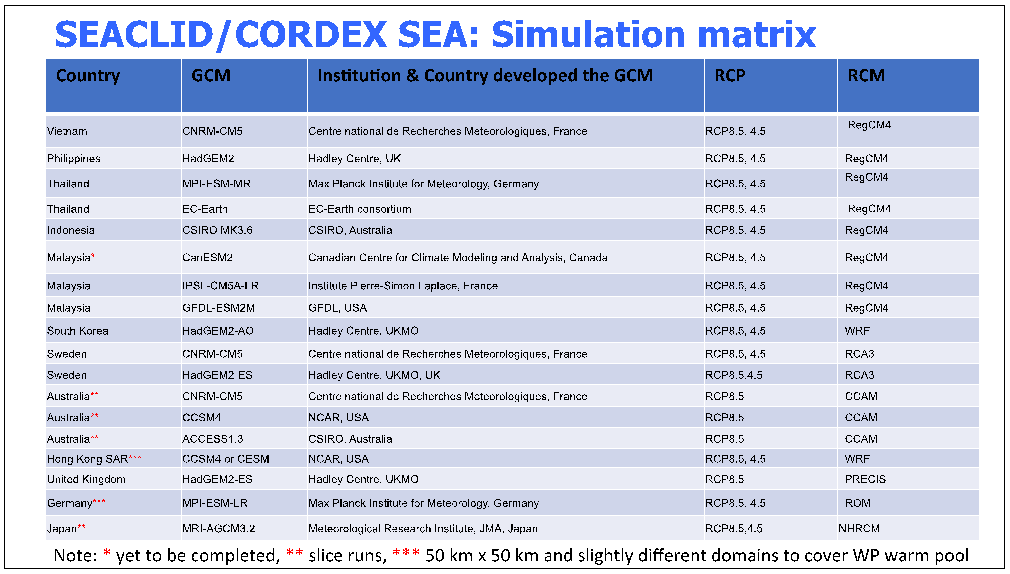
Despite these difficulties and challenges, we viewed this project as a great opportunity to enhance capacity building and increase the participation of early-career scientists, enhance networking and increase visibility in terms of scientific publications, and narrow data and knowledge gaps in regional climate change information. Positive progress in this aspect is detailed below:
1. We have carried out four project workshops so far: Jakarta (inception workshop: October 2013), Bangkok (2nd technical workshop; June 2014), Manila (3rd technical workshop; May 2015), Hanoi (4th technical workshop; November 2016). Through these workshops, we received participation from various other groups outside the project and solicited input from stakeholders. These workshops strengthened networking of scientists and practitioners within and outside the region.
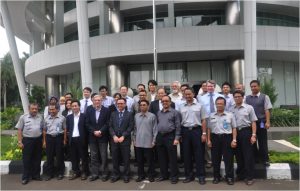 |
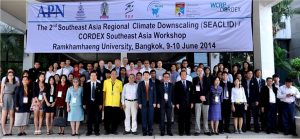 |
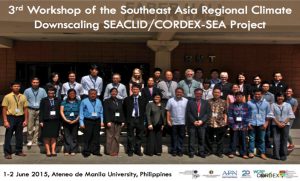 |
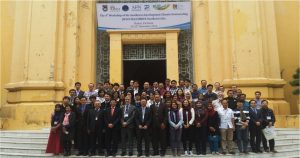 |
Photo2: (Group photos during SEACLID/CORDEX Southeast Asia Workshop. Clockwise from top left: Inception Workshop (October 2013, Jakarta), 2nd Workshop (June 2014, Bangkok), 3rd Workshop (June 2015, Manila), 4th Workshop (November 2016, Hanoi)
2. In collaboration with other institutions (e.g. ICTP, NCAR), and through additional support from WCRP, we managed to organize two regional modelling training workshops. The first was the Southeast Asia Regional Climate Model (RegCM) Workshop, held in Manila from 25-29 May 2015. The second was the WRF Training Workshop, held in Bangkok from 16-18 October 2017. Participants who attended these workshops were mostly young scientists who were not necessarily directly involved in SEACLID/CORDEX Southeast Asia.
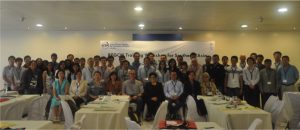 |
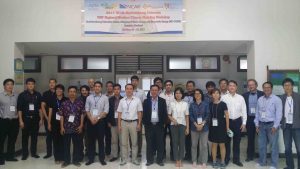 |
Photo3: (Top) RegCM Modeling Workshop (May 2015, Manila; (Bottom) WRF Workshop (October 2017, Bangkok)
3. In our effort to translate the model output and analyse results for scientific publications, we conducted two manuscript writing workshops to ensure that the effort was well coordinated. Currently, we have published 6 scientific papers and are in the process of completing a number of manuscripts from the results of the simulations. In this interview, we are unable to share with the readers detailed results of the simulations as these scientific findings would need to be peer-reviewed and published in reputable journals. However, at this stage we can assure the readers that the simulations provided us with some very interesting and significant results, e.g. drying tendency over Indonesian region (especially Sumatra and Kalimantan) from the period June to November in future periods for middle (RCP4.5) and high-end (RCP8.5) emission scenarios. This finding implies that if, in the present period, such dryness occurs only during an El Niño event, in future such dryness could be a yearly occurrence. Drought conditions would be much worse in the future period if El Niño occurs, signifying the combined effect of climate variability and climate change.
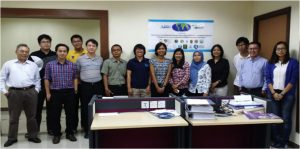 |
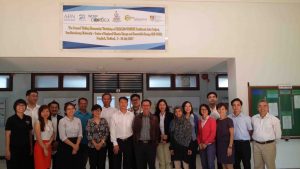 |
Photo 4: (Top) First Manuscript Writing Workshop (August 2014, Kuala Lumpur); (Bottom) Second Manuscript writing workshop (July 2017, Bangkok)
4. We have more than 15 graduate students (MSc and PhD) that have been engaged in research for SEACLID/CORDEX Southeast Asia. While some have completed, the majority are in the process of finishing their thesis.
5. A climate research centre has been established at Ramkhamhaeng University, Bangkok, Thailand and was named as Ramkamhaeng University’s Center of Regional Climate Change and Renewable Energy (RU-CORE) (http://www.rucore.ru.ac.th/). The establishment of this centre reflected a very strong commitment of the President of Ramkhamhaeng University, Prof. Wutisak Lapcharoensap, based on the recommendation letter put forward by members of SEACLID/CORDEX Southeast Asia to the President during the 2nd technical workshop in June 2014. Further, a number of brief meetings between myself and President. Dr Jerasorn Santisirisomboon, a member of SEACLID/CORDEX Southeast Asia, played a much bigger role in pursuing the approval of the centre. This centre is currently hosting the SEACLID/CORDEX Southeast Asia ESGF Data Node, thanks to the support of local funding institutions: Thailand Research Fund (TRF) and National Research Council of Thailand (NRCT). RU-CORE is the secretariat of the second phase of SEACLID/CORDEX Southeast Asia, where the downscaling activity will continue for a much higher resolution (<5km) over a number of sub-domains in the next 2-3 years. RU-CORE is also envisioned to be the focal point for SEACLID/CORDEX Southeast Asia in engaging the user community in Thailand as well as the Southeast Asia region, and act as a platform for the university in developing a graduate academic program in climate change, which will serve the needs in Thailand as well as the region.
With the progress that has been made, we think we are moving in the right direction. However, more effort is needed to sustain the momentum. Funding institutions and donors would need to play a role in funding this kind of research, especially in impact-assessment studies that will be using SEACLID/CORDEX Southeast Asia data.
APN Secretariat: What do you think of the overall engagement of scientists in climate downscaling studies in SEA region, in terms of quality and quantity? What, in your opinion, can be done to strengthen it?
FT: The SEACLID/CORDEX Southeast Asia provided a platform for “pockets” of expertise in regional climate simulation that existed prior to the establishment of this project to grow and increase visibility. In terms of overall engagement of scientists in climate downscaling studies in the Southeast Asia region, I think it is very encouraging and satisfactory, especially in the five main countries: Malaysia, Thailand, Viet Nam, Indonesia, and the Philippines. However, more could be done. For example, in Indonesia, more universities could be involved in the project. For Lao PDR and Cambodia, levels of engagement are much lower and confined to attending the workshops. At the initial stage of the project, attempts were made to secure graduate students from both Lao PDR and Cambodia to come to Malaysia to pursue MSc and PhD degrees with funding from the National University of Malaysia. Eventually, in Malaysia, we managed to engage one foreign student from Indonesia to pursue a PhD, which is near completion. In addition, we have a number of local students pursuing MSc and PhD degrees. A number of graduate students are also pursuing MSc and PhD degrees in Viet Nam, Thailand and the Philippines by conducting research in SEACLID/CORDEX Southeast Asia simulations. At a later stage, a graduate student from Cambodia, who is currently doing his PhD at Kyoto University, Japan, joined the project and will be using SEACLID/CORDEX Southeast Asia simulation data for his study.
This momentum of advancement of regional climate downscaling studies in the Southeast Asia region needs to be continued and sustained. While the level of expertise may not be as good as that of developed country scientists, local scientists are supposed to better understand the local processes in this region. Hence, engaging local scientists in advancing understanding of how local processes are influenced by climate change should be encouraged and promoted whenever the opportunity arises. Large-scale studies by scientists from developed countries that seek understanding of how local processes are influenced by large-scale processes and climate change should engage local scientists as co-investigators. Connections must be made.
In the second phase of SEACLID/CORDEX Southeast Asia (also funded by APN) downscaling activities are continuing at a much higher resolution (<5 km) over a number of sub-domains. The intention is for the group to go into convective permitting scale and investigate the model ability to resolve various local processes. Along this line, many possible projects can be implemented as well and this is possible under the CORDEX Flagship Project. This is a means for CORDEX to endorse a viable and scientifically credible project. In developed countries, an endorsement could translate into funding. However, this may still not be the case for developing countries especially in the Southeast Asia region, where lack of funding is still a significant issue.
APN Secretariat: Has there been any responses to the results of your research project from other communities, such as practitioners or policymakers? If so, could you please elaborate what kind of responses you have received?
FT: Throughout the project duration, promotion of the project has been made via scientific and public talks, presentations, media engagement, and participation in technical workshops, etc. However, since the findings of the study have yet to fully documented, the efforts were rather ad-hoc in nature. However, one particular NGO, Christian Aid, has been following the progress of this project and has participated in three of the technical workshops. Christian Aid is also actively participating in UNFCCC COP processes. Both project members and Christian Aid have agreed that key findings of the project must be compiled into a Summary Report that policymakers could easily understand. Currently, Christian Aid and SEACLID/CORDEX Southeast Asia is still negotiating on how the production of such a report could be facilitated.
Promotion of SEACLID/CORDEX Southeast Asia must continue probably in a much organized and funded bridging program as mentioned above. In the meantime, as the Project Leader, I will continue to give talks and outreach the project. I have been invited to the Food and Agriculture Organization (FAO), United Nations in Bangkok on 14 December 2017, to give a talk on SEACLID/CORDEX Southeast Asia and also to have a discussion with the FAO team in terms of how to engage users in FAO country members within the region. On 23 November 2017, I also gave a talk at LESTARI, the National University of Malaysia on key findings of SEACLID/CORDEX Southeast Asia. Other members of the project have also been encouraged to conduct similar talks in their respective countries.
APN Secretariat: How do you see SEACLID/CORDEX-SEA contributing to the larger WCRP/CORDEX programme in the long term and how has the project, overall, impacted the WCRP/CORDEX programme?
FT: Incorporating SEACLID into CORDEX and adopting it as its fourteenth domain is a success story, particularly in facilitating WCRP programme making an in-road into the Southeast Asia region. Of course, WCRP has many other programmes and, in most of these, the involvement of regional scientists from the region are minimal if none at all.
APN Secretariat: Is there anything else (either related to the project or otherwise) you would like to share with our audience?
FT: The first SEACLID/CORDEX Southeast Asia phase is nearing completion. In order for such information to be relevant and impactful for policymakers in their decision-making processes, the VIA user community would have to use and translate the data into information on how future climate change is going to impact critical sectors.
Any question regarding the project can be directed to the project leader, Prof. Fredolin Tangang at [email protected]